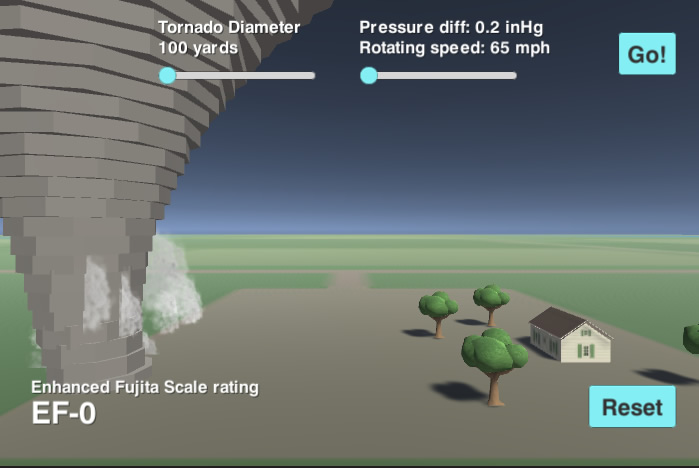Tornado Tracking and Simulation- Free Lesson
A tornado is a violently rotating column of air that is in contact with both the surface of the Earth and a cumulonimbus cloud or, in rare cases, the base of a cumulus cloud.
Describe what tornadoes are and how they form. Click on the tornado simulator below. Once loaded, try to adjust wind speed and diameter of vortex. Observe how these variables have effects on surrounding objects.
1. Watch this video to learn some basics info about tornadoes.
2. Watch this video to learn from a stormchaser about how tornadoes form.
3. Watch this video to learn about the two different types of tornadoes & how they are rated.
What is a tornado?
Tornadoes are one of the most violent and powerful types of weather. They consist of a very fast rotating column of air that usually forms a funnel shape. They can be very dangerous as their high speed winds can break apart buildings, knock down trees, and even toss cars into the air.
How do tornadoes form?
A large thunderstorm occurs in a cumulonimbus cloud
A change in wind direction and wind speed at high altitudes causes the air to swirl horizontally
Rising air from the ground pushes up on the swirling air and tips it over
The funnel of swirling air begins to suck up more warm air from the ground
The funnel grows longer and stretches toward the ground
When the funnel touches the ground it becomes a tornado
Types of Tornadoes?
Supercell - A supercell is large long-lived thunderstorm. It can produce some of the largest and most violent tornadoes.
Waterspout - A waterspout forms over water. They usually dissipate when they hit land.
Landspout - A landspout is similar to a waterspout, but on land. It is weak and is not associated with a vortex of air from a thunderstorm.
Gustnado - A small tornado formed at a weather front by gusts of wind.
Multiple vortex - A tornado with more than one spinning tube of air.
Tornado Warnings and Watches
Tornadoes can be very dangerous. In order to save lives, the National Oceanic and Atmospheric Administration (NOAA) issues tornado "watches" and "warnings." A tornado "watch" means that weather conditions are favorable for a tornado to be produced. A tornado "warning" means that a tornado is happening right now or is going to happen soon. During a tornado "watch" you should begin preparing for a tornado. When you hear a tornado "warning", it is time to take action.
Warm-Up: 1. Do you think tornado warnings or tornado watches are more serious? Why? (answer on a piece of paper) 2. Use this Quizziz to see what you already know about tornadoes and other types of severe weather.
Answer the following questions on a piece of paper:
1. What are the steps for a tornado to form?
2. What action steps should you take during a tornado watch?
3. What action steps should you take during a tornado warning?
4. Which is more serious - a tornado watch or warning?
What are the steps for a tornado to form?
a. A large thunderstorm occurs in a cumulonimbus cloud
b. A change in wind direction and wind speed at high altitudes causes the air to swirl horizontally
c. Rising air from the ground pushes up on the swirling air and tips it over
d. The funnel of swirling air begins to suck up more warm air from the ground
e. The funnel grows longer and stretches toward the ground
f. When the funnel touches the ground it becomes a tornado
What action steps should you take during a tornado watch?
1) Have a radio or TV nearby so you can receive further updates in a timely manner.
2) Grab your mobile devices and a portable backup battery charger.
3) Take notice of the weather conditions around you. Clouds swirling in the sky or creating shallow funnels are signs that a tornado may form. Be aware that even if a tornado does not form, severe thunderstorms pose a safety risk.
4) Locate all members of your family and your pets.
5) Review your plans for emergencies and natural disasters.
6) Make sure your emergency supplies are accessible.
What action steps should you take during a tornado warning?
1) Seek shelter in your pre-designated safe zone immediately. If you are not home or cannot get to your safe zone, protect yourself from flying debris under heavy furniture, such as a sturdy table, and stay clear of windows.
2) (if driving) Park your car and go outside. If shelter is unavailable, lie on a low, flat area of ground with your arms over your head.
3) Keep your radio, or TV tuned to a local station for updates. It is imperative to have an alternative energy source, such as batteries, in case the power goes out.
4) Stay alert for sirens, but do not leave your safe zone or shelter until you receive a signal that the warning is lifted. 4. Which is more serious - a tornado watch or warning?
5) A tornado warning

